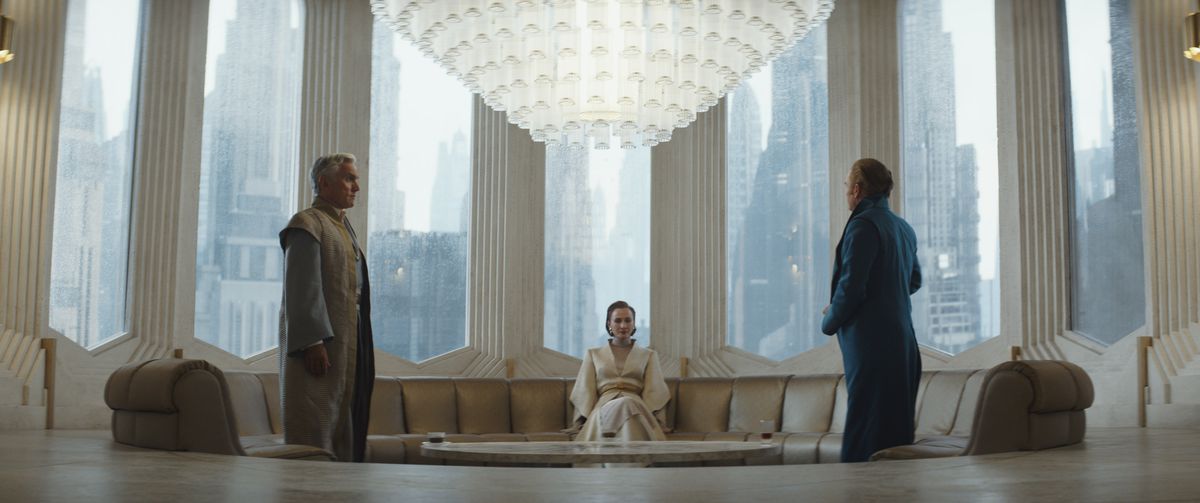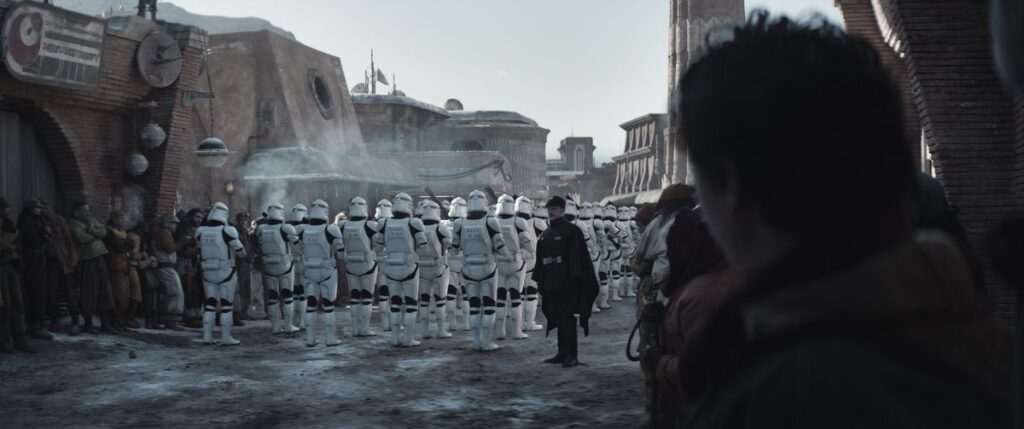It sneaks up on you, how well you know Ferrix by the end of Andor’s first season. At first it’s deceptively like Tatooine: a miserable place that’s meant to be left behind by its protagonist, swept away by more exciting things that we’ve come to expect from Star Wars. And although Cassian Andor does leave to have those Star Wars adventures, Andor never fully leaves Ferrix. It lingers on details: the wall where workers hang their gloves at the end of a shift, or the bell tower where a rugged man beats an anvil with ceremonial grace. There are social movements like the Daughters of Ferrix, a small but active smuggling network, and corporate cops that the working class have developed elaborate ways to screw with.
None of this is ever fully explained to the viewer. They’re just visiting, and Andor is OK with you overlooking Ferrix at first. Maybe not by the end, though. By the end the viewer might feel like they’re part of something.
Andor’s season 1 finale does something remarkable with its climax. It gets smaller, bringing most of its disparate players — ISB officer Dedra Meero, the remaining rebels in the burgeoning movement, saboteur Luthen Rael, and wannabe Imperial Syril Karn — back to Ferrix. It’s Maarva Andor’s funeral, and the many people hunting for Cassian Andor correctly anticipate that he won’t be able to resist paying respects to his adoptive mother.
In Andor’s last few visits to Ferrix, the Empire has effectively taken over the place. Imperials have slowly increased in number on the town’s crowded streets, watching everything, making an already meager existence almost impossible. They are taking people that might know about any rebellious activity, like Bix, and torturing them until they can barely stand. They’re a blight on an already bleak horizon, and that’s before they get even more troops in to hunt Cassian down.
Image: Lucasfilm
Much of the final episode is centered around Maarva’s funeral. It’s an elaborate, beautiful, and somber thing, steeped in ceremony that both honors the working-class roots of Ferrix and imbues it with grace. There’s a processional and a marching band and a stone to honor her, all of it juxtaposed against the increased Imperial presence, like two lines of fuel spilling through the streets. Then, when a posthumous message from Maarva speaks of resistance, of the boot that’s been on Ferrix’s neck for too long, a spark sets the town ablaze.
Andor, as The Atlantic’s Adam Serwer wrote, has always been concerned with why people in the Star Wars universe choose the sides that they do.
“The show is populated by ordinary people who become revolutionaries or Imperial cronies, not just magic monks, space-cowboy smugglers, or ruthless bounty hunters,” Serwer writes. “Similarly, the show’s factions, whether part of the Rebels or the Empire, are not monolithic but troubled by their own divisions and rivalries. The show, in other words, is interested in what kind of person joins the Rebels or goes Imperial, and why.”
Ferrix is where this philosophy comes home to roost. In Andor’s first season, nearly every character has to decide where they stand, and that inflection point is different for every character. Some, like the young, radical manifesto writer Nemik, are morally opposed to the Empire seemingly from the start, and stand in opposition simply because it’s the moral thing to do. Others, like Mon Mothma, think they can safely resist from inside the system while still holding on to their scruples — something she is disabused of when, in the season’s final episodes, she is forced to deal with a white-collar criminal if she wants to do her part. She surprises herself and entertains the offer, even if it means marrying her daughter off to a criminal heir.

Image: Lucasfilm
Few need more convincing, however, than Cassian Andor. From the start, showrunner Tony Gilroy and the writers he’s collaborated with have made it clear that Cassian is no fool. He’s a man who knows what the Empire is doing and will never play along, but as he regularly insists to rebels like Vel Sartha, there’s no use in fighting the system, just getting what’s his. Even going to prison did not change his outlook, only furthering his resolve to run and disappear.
Cassian is running from the person we know he becomes in Rogue One, and in spite of a strong sense of self-preservation, he is not the island he wishes he could be. He has people, and those people are on Ferrix — even if, like with Maarva, all he can do is say goodbye.
So Cassian Andor returns to Ferrix, the place that gave him his name, the place where he stopped being Kassa of Kenari and became someone else, someone angrier. And it’s on Ferrix where he finally sees the limits of his lonely form of anger, as B2EMO broadcasts a posthumous message from Maarva that inspires her mourners to action, to rise up against the Imperials that have been slowly suffocating them for no good reason. In the ensuing revolt, all of Ferrix takes part: the man in the belltower, the laborers and traders, the Daughters of Ferrix. They gain something powerful in their rebellion, just as Andor loses everything.
Andor writes its thesis on the streets of this forgotten little town — rebellions must be personal, but that is only the first step. They must also be communal, crossing diverse socioeconomic boundaries and ideologies, united by a simple idea: Enough. Once that connection happens, then a rebellion can become a revolution. It’s on the streets of Ferrix that the rebels become Rebels. It’s the place where Cassian Andor is broken, and ready to be rebuilt into someone that can help shape this communal anger, after finally reaching the limits of his own.

